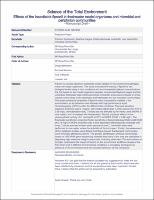Please use this identifier to cite or link to this item:
https://repositorio.usj.es/handle/123456789/1091
| Title: | Effects of the insecticide fipronil in freshwater model organisms and microbial and periphyton communities (Versión aceptada) |
| Authors: | Pino Otín, Rosa


Ballestero Fernández, Diego Navarro, Enrique 


Mainar, Ana M. 


Val Pulido, Jonatan |
| Keywords: | Fipronil; Ecotoxicity; Daphnia magna; Chlamydomonas reinhardtii; River periphyton; Microbial communities |
| Issue Date: | 16-Oct-2020 |
| Publisher: | Elsevier |
| Citation: | Pino-Otín MR, Ballestero D, Navarro E, Mainar AM, Val J. Effects of the insecticide fipronil in freshwater model organisms and microbial and periphyton communities. Sci Total Environ. 2021 Apr 10;764:142820. doi: 10.1016/j.scitotenv.2020.142820. Epub 2020 Oct 16. PMID: 33121789. |
| Abstract: | Fipronil is a broad-spectruminsecticide whose release in the environment damagesmany non-target organisms. This study evaluated the toxicity of fipronil at two biological levels using in vivo conditions and environmentally relevant concentrations: the first based on two model organisms (aquatic invertebrate Daphnia magna and the unicellular freshwater alga Chlamydomonas reinhardtii) and a second based on three natural communities (river periphyton and freshwater and soil microbial communities). The physicochemical properties of fipronil make it apparently unstable in the environment, so its behaviour was followed with high performance liquid chromatography (HPLC) under the different test conditions. The most sensitive organism to fipronil was D. magna, with median lethal dose (LC50) values from 0.07 to 0.38 mg/L (immobilisation test). Toxicity was not affected by the media used (MOPS or river water), but it increased with temperature. Fipronil produced effects on the photosynthetic activity of C. reinhardtii at 20 °C in MOPS (EC50 =2.44 mg/L). The freshwater periphyton presented higher sensitivity to fipronil (photosynthetic yield EC50 of 0.74 mg/L) in MOPS and there was a timedependent effect (toxicity increased with time). Toxicity was less evident when periphyton and C. reinhardtii tests were performed in river water, where the solubility of fipronil is poor. Finally, the assessment of the metabolic profiles using Biolog EcoPlates showed that bacteria communities were minimally affected by fipronil. The genetic identification of these communities based on 16S rRNA gene sequencing revealed that many of the taxa are specialists in degrading highmolecularweight compounds, including pesticides. Thiswork allows us to better understand the impact of fipronil on the environment at different levels of the food chain and in different environmental conditions, a necessary point given its presence in the environment and the complex behaviour of this compound. |
| URI: | https://repositorio.usj.es/handle/123456789/1091 |
| ISSN: | 1879-1026 |
| Appears in Collections: | Artículos de revistas |
Files in This Item:
| File | Description | Size | Format | |
|---|---|---|---|---|
| Effects of the insecticide version aceptada.pdf | 3,54 MB | Adobe PDF |  View/Open |
This item is licensed under a Creative Commons License

